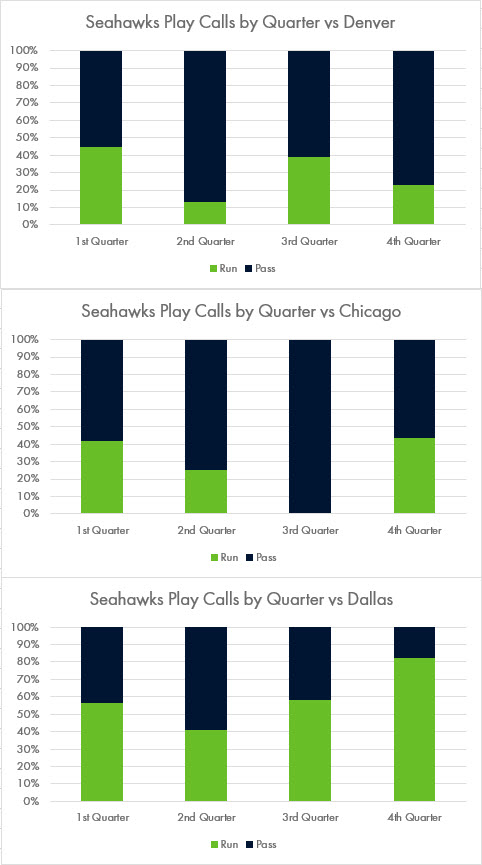Cowboys fans streamed into CenturyLink Field full of arrogance. It is their way. Facing a winless Seahawks team that had looked lost on offense with a Dallas defense that had dominated their first two opponents gave some credence to their confidence. Seattle wore the first two weeks like an early Halloween costume. They looked like they were trying to be something they are not. Then, something happened. Maybe a lot of things happened. Someone finally found a way to hold a mirror in front of Pete Carroll and show him how far he had strayed from the identity that had served him so well. No more bizarre personnel decisions. No more relying completely on the quarterback. In their place was a stubborn reliance on a physical run game, a playmaking defense, and lethally efficient passing attack. Finally, the return of Seahawks football. That it came with a side order of dejected Cowboys fans was an extra treat.
The Seahawks had run the ball on just 32% of their plays before this game against Dallas. That ranked 27th out of 32 teams in the NFL. Statisticians will tell you that, alone, is not an indicator of an identity shift in playcalling. Teams that fall behind in games pass more, especially in the fourth quarter, than teams that are ahead. That is less the case when a team is within one score of their opponent, as Seattle has been for much of their games against Denver and Chicago. What we saw against the Cowboys was a far greater commitment to staying with the run throughout the game. Seattle finished the game having run the ball 58% of the time. Look at the playcalling trends.
The Seahawks started similarly in all three games, but quickly abandoned the run in the first two by the time they reached the second quarter. Not against Dallas. They ran the ball on first and second down and were creating more 3rd and 5-9 yard situations instead of the 3rd and 10+ we had seen too much of against the Broncos and Bears. In fact, the Seahawks faced just one 3rd and longer than 9 through the first three quarters of the game. That was a 3rd and 10, and Russell Wilson hit Chris Carson for a 19-yard gain. Seattle had 12 third down situations through those first three quarters against Dallas. Only three of them were longer than 7 yards.
Compare that to the Bears game where they had 10 third down chances through three quarters and 6 of them were longer than 7 yards, including a 3rd and 17 and 3rd and 22. They had 9 third down through three quarters versus the Broncos and 5 of them were longer than 7 yards, including a 3rd and 17, 3rd and 12, 3rd and 16, and 3rd and 11. No team in the NFL consistently converts 3rd and long. Sure, some are better than others, but nobody would rather be in those situations than 3rd and 5-7 yards.
No wonder Seattle finished 7/16 on third downs in this game after being atrocious earlier on. A willingness to take a two-yard gain on a first down run, and maybe even another two-yard gain on second down now and then, fits the strengths of this offense better. None of this is to say the team should swing the pendulum all the way in the other direction.
Russell Wilson compliments a stubborn run game perfectly. He made some spectacular throws against Dallas, and would have had an even better game if Brandon Marshall had not dropped multiple passes. There appeared to be more play-action, which plays to Wilson’s strengths. Again, the advanced stat crowd will tell you that the effectiveness of the run game appears to have no bearing on the success rate of play-action passes. That is an interesting insight in principle, but the coaches are probably much more likely to call play-action passes when they believe they have the defense paying attention to the run.
You better believe Brian Schottenheimer was thinking the Cowboys were paying attention to Chris Carson. The Seattle offensive coordinator finally, finally, finally, gave the second-year running back a chance to impact the game. It was almost as if they were making up for lost time. Carson finished with 32 carries, which was the most by a Seahawks running back since Marshawn Lynch in 2011 in a game versus Ray Lewis and the Ravens. That was the most Lynch ever carried the rock in a Seattle uniform.
The run game was not necessarily very efficient, but you better believe it was a significant factor in the outcome. Carson wound up with the first 100 yard rushing game for a Seahawks running back since Thomas Rawls in week 13 of the 2016 season. He had the first red zone touchdown for a Seahawks running back in the last 18 games. All this came at the cost of carries for Rashaad Penny, who had just 3 on the afternoon. Given that it sounds like Penny still has weight to lose, and has been largely ineffective in his opportunities, the next step is to see C.J. Prosise getting a ticket out of the doghouse to take over 3rd down and 2-minute duties.
That pairing gives the Seahawks the most upside in the backfield, with playmakers who can change the game carrying or catching the ball. If the coaches never take that step, it will still be a victory just knowing that Carson is finally playing the role he has earned. Assuming, of course, this was not a one-game departure from insanity.
Now that they have established Carson, it is important to take care of him as well. It is hard for any back to stay healthy over the course of a season, let alone one carrying the ball over 30 times. Optimal would be 20-25 touches.
Dallas came into this game with the 3rd-ranked scoring defense, allowing just 14.5 points per game, and one of the best pass rushes in football. The Seahawks offensive line deserves credit for stepping up and helping clear the way to 24 points and just 2 sacks. They did it all without their starting center in Justin Britt, and with J.R. Sweezy getting his first start ever at left guard. Germain Ifedi had his third tough matchup in a row, going against Demarcus Lawrence, and appeared to hold his own.
The biggest surprise of the young season, though, has to be a Seahawks defense that is showing more gumption than anyone should have rightfully expected. Leading the list of players stepping up on that side of the ball is Bradley McDougald, who is playing like one of the best safeties in football. His punch out on Ezekiel Elliott’s long run was a pivotal moment in the game, and emblematic of the type of play this defense was known for in past years.
Earl Thomas finished with two interceptions, making it three straight games that a Seahawks secondary player has had two picks. If this proves to be the last game Thomas plays in Seattle, a real possibility, he will have gone out in style.
Seattle also found a pass rush that had been missing to this point. Five sacks and 10 quarterback hits were season highs.
The truth is that Dallas is not a very good team. Neither, though, were Denver or Dallas. Playing at home helped a lot, but the renewed commitment to an identity that matches the personality and personnel of the team was at least as important. Would the Seahawks have won one or both of their previous two close games had they utilized Carson the way they had in this game and stayed committed to the run? There is a decent chance they would have. Now the goal becomes finding balance and not overcorrecting. You can be sure there will be plenty of fans who now get aggravated when the team runs too much. This is not about a pledge to run on first and second down on every series forever and for always. It is about establishing a physical presence that allows the offensive line to hit instead of being hit, and for your second best healthy offensive player to have an opportunity to impact the game.
The Seahawks did not prove they were good on Sunday. They did rediscover a formula that should keep them in nearly every game, and allow Wilson’s late-game heroics to be in pursuit of victory instead of avoiding a blowout. The coaches were rightfully criticized for the decisions that were made during the first two losses, and should be commended for admitting their mistakes and finding their footing. Now we watch to see if they can repeat the process next week in Arizona.

